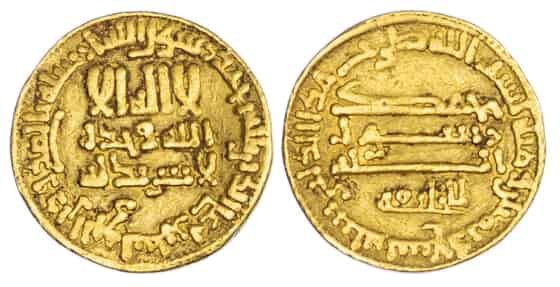Caliph Harun Al-Rashid makes an appearance as a character in many Arabian Nights stories. In fact, Harun al-Rashid takes an active role in a lot of the stories in the book. Therefore, he wasn’t a fictitious character, He was a genuine historical figure who made an enduring contribution to Islamic society and history. He was a famous Caliph and a great ruler. Indeed, a significant historical character under whose rule the Islamic Empire attained unprecedented heights in terms of knowledge, sciences, philosophy and arts.

The Caliph Harun al-Rashid (History of the Abbasid dynasty)
Also Read: The Early Landscape of Iberia and the Spanish Peoples
The Islamic Empire was at its height under Harun al-Rashid, reign's which lasted from 786 until 809 A.D. The capital of his rule was the city of Baghdad in Iraq. Baghdad was widely regarded as one of the most magnificent cities of its time.
Caliph Harun al-Rashid established the "House of Wisdom" (Bayt al-Hikma), It brought together the most illustrious intellectual leading figures in science, mathematics, and philosophy under one roof. Through their work, the "House of Wisdom" (Bayt al-Hikma) helped advance knowledge and, in turn, civilization. Harun al-Rashid was a contemporary of France's Emperor Charlemagne, they frequently interacted and exchanged gifts.
Harun al-Rashid was the fifth Caliph of the Abbasid dynasty. The Abbasid are descendants of Abbas, an uncle of the Prophet Muhammed. The Umayyad dynasty defeated Caliph Ali at Karbala in Iraq. Caliph Ali was assassinated in 661 A.D. The Umayyads had their base in Damascus, Syria. And later the Abbasids turned against them to establish a new rule in Baghdad.

Family and Childhood
Harun al-Rashid was the son of al-Mahdi, the third caliph of the Abbasid dynasty (reigned 775-785), and al-Khayzuran, a former person Yemeni slave girl with a powerful personality who had a significant impact on the state issues during the reigns of her husband and sons. Harun was born when the old prince, al-Hadi, was four years old. The princes were raised in the Baghdad court and instructed in the Qur'an (Islam's sacred book), poetry, music, stories about the Prophet Muhammad, the early history of Islam, and judicial. His tutor was Yahya the Barmakid, he was a devoted supporter of his mother.
Harun served as the official expedition leader against the Byzantine Empire in 780 and 782, although it is likely that the military decisions were determined by the skilled generals who accompanied him. When the expedition of 782 arrived at the Bosporus, directly across from Constantinople, peace was made on terms that benefited Muslims. Because of his success, Harun was given the honorific title of al-Rashid, which means "the one following the right path", and was made governor of Ifriqiya (Tunisia), Egypt, Alsham (Syria), Armenia, and Azerbaijan, with the Promote of his tutor Yahya to become the actual administrator.
He was also named the second successor to the throne. These actions were most likely planned by al-Khayzurn and the tutor Yahya. Al-Mahdi is even reported to have been persuaded by the two to name Harun his immediate successor; however, al-Mahdi passed away in 785 without formally modifying the succession. Al-Hadi was elected caliph, and Harun consented. Through some narrations that conveyed the events of the Abbasid caliphate, some stories claimed that al-Khayzuran was responsible for al-unexplained Hadi's death in 786 because he had opposed her dominance.
On September 14, 786, Harun al-Rashid succeeded to the throne as caliph and took control of an empire that extended from the western Mediterranean to India. He appointed Yahya the Barmakid as his vizier or top minister. Al-Fadl and Jafar, two of Yahya's sons, were attached to him since, during this time, the vizier was not only a policymaker but also had a staff of administrators working for him to carry out his orders. Up to her passing in 789, Al-Khayzuran had a major impact on the government. Following that, the Barmakids dominated the empire until 803, but the caliph was not entirely dependent on them because other individuals also held some positions of authority.
There was a lot of internal conflict during the reign. In Egypt, Syria, Yemen, and other eastern provinces, there have been uprisings in different areas for regional reasons, but the central government was able to put an end to them and restore order. After a series of inefficient governors, Ifrqyah (or Tunisia) was given to Ibrahim ibn al-Aghlab in 800. For semi-independent status, he agreed to pay a large annual sum to Baghdad.
The Aghlabid family continued to control the province for more than a century without intervention from Baghdad, and similar status was given to other regional dynasties. While this was immediately financially advantageous to Harun, it marked the beginning of the caliphs' loss of power. Although historians' books are filled with revolts, the empire as a whole was mostly calm.
As a result, trade increased and industry (textiles, metal products, paper, etc.) experienced significant growth. The ensuing prosperity made it feasible for the caliph and other important figures of the empire to acquire a great fortune.
The Abbassid wealth and prosperity under Harun al-Rashid
Though exaggerated, 'The Thousand and One Nights' magnificent descriptions of Harun and his court had a good deal of factual support. Since Baghdad's founding in 762, untold wealth had entered the region. The leading men, and even more their spouses, competed in excessive luxury, and during the reign of Harun al-Rashid, it reached previous levels unheard is. His wife Zubaydah, who is a descendant of the Abbassid family, would only place gold and silver dishes with gems on her table.
The vast Harun's palace housed a large number of eunuchs, concubines, singing girls, and servants. As a lover of poetry and music, he lavishly presented presents to deserving poets and musicians.
However, aside from philology, the intellectual disciplines were still growing in the Arab region, and the magnificent culture of the court had some limitations. There was also a darker, tougher side. Harun could choose to watch cockfights and dog fights over music. In his capacity as caliph, he could impose an immediate death sentence. In the tales of his nightly wanderings about Baghdad in disguise, he is frequently joined by companions like Jafar the Barmakid and the great poet Ab Nuwas, as well as Masrur the executioner.
The Islamic Empire/Caliphate was already in the midst of what historians referred to as the "Golden Age of Islam" by the time Harun al-Rashid assumed the Caliphate. In a time when Europe was still "in darkness", Islam predominated as a cultural influence in the fields of art, philosophy, and science. Indeed, Islamic culture was at its height, and thanks to its numerous ground breaking studies and translations of Chinese, Indian, and Latino-Greek classics into Arabic and later, into Latin, that would help bring the Age of Enlightenment to Europe later.
At that time, Europe was entering the Renaissance era. With a population of one million, the City of Baghdad was one of the most prosperous cities of its time. As the capital of the Islamic Empire and the location of the House of Wisdom, a Center of Learning unlike any other, it was also a prized area for education, drawing students from the European nobility to its highly regarded schools and libraries. The cultural "Centre" of the world at the time was Baghdad. It was a time when scientific and philosophical learning flourished by the cultural advancements of Islamic scholars, scientists, and philosophers. And Europe as we know it then made good use of the explosion in knowledge.
The Fall of Barmakids and the end of Harun al-Rashid
After the execution of Jaafar the Barmakid who was the close friend of Harun al-Rashid for reasons that historians disagreed with it. Began the fall of the Barmakids, who had been primarily responsible for empire administration for more than 16 years and had provided funds for the court’s luxury and lavishness.
Many interests throughout the empire were being drawn to two opposed poles. The secretaries, or civil servants, were on one side, along with many Persians and men from the eastern provinces, while the ulama, or religious scholars, were on the other, along with many Arabs and people from the western districts. Al-Fadl ibn al-Rabi, the new vizier, supported the second group of interests while the Barmakids supported the first, hence it is possible that this political division played a role in the change of government.
At least fifty years were spent in the conflict between the two interest groups. As a demonstration of his recognition, Harun gave Iraq and the western provinces to his son al-Amin, and the eastern provinces to his son al-Mamun, who would take over after him. His tutor was al-Fadl ibn al-Rabi after 803, and he was the son of the Arab princess Zubaydah. Al-Mamin was the son of a Persian slave girl, and in 803 he had al-Fadl ibn Sahl, a Barmakid protégé, as his instructor. Because of the conflict between his two sons after his death, Harun al-Rashid has come under fire to divide the empire and contribute to its fall.
Al-Fadl ibn al-Rabi was not as effective as the Barmakid viziers, and Harun’s judgments may have carried greater weight. There were more effective operations against the Byzantine Empire, but in the fall of 808, while en route to personally handle a serious two-year revolt in Khorsn (in Iran), Harun al-Rashid became ill and passed away at Tüs (close to present Meshed). He was succeeded as caliph by Al-Amin.
Conclusion
Indeed, Harun al-Rashid made an impact on history. He was a strong supporter of learning and, as such, gave motivation to Islamic culture and ideas through his House of Wisdom (Bayt al-Hikmah). With the rise of the Sufi culture, poets, and thinkers, that period showed a driving religious and cultural force that would help to assist in the dissemination of Islamic knowledge and ideas through poetry, philosophy, and other literary forms.
Harun al-Rashid was not a passerby in the Arabic Nights Tales. He was certainly much bigger. His name and fame live on today, not only in Baghdad, but throughout the Middle East and, indeed, the Islamic world.
Bibliography
- Al-Masudi, The Meadows of Gold, The Abbasids, translation: Paul Lunde and Caroline Stone, Kegan Paul, London and New York, 1989
- Al-Tabari, The History of al-Tabari, volume XXX, »The ‘Abbasid Caliphate in Equilibrium » transl. C.E. Bosworth, SUNY, Albany, 1989
- Clot, André. Harun Al-Rashid and the Age of a Thousand and One Nights. New Amsterdam Books, 1990
- St John Philby, Harun al Rashid, P. Davies, London, 1933.
- Einhard and Notker the Stammerer, Two Lives of Charlemagne, translation: Lewis Thorpe, Penguin, Harmondsworth, 1969, 1977
- John H. Haaren, Famous Men of the Middle Ages, Good Press, 2021
- William Muir, The Caliphate, its rise, decline, and fall, Kessinger Publishing, LLC, September 20, 2004
- Theophanes, The Chronicle of Theophanes, translation: Harry Turtledove, University of Pennsylvania Press, Philadelphia, 1982
- Norwich, John J. Byzantium: The Apogee. Alfred A. Knopf, 1991
- Zabeth, Hyder Reza. Landmarks of Mashhad, Alhoda, UK, 1999
